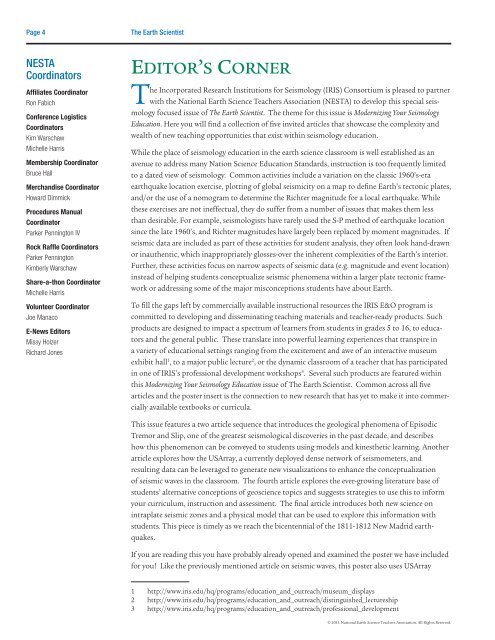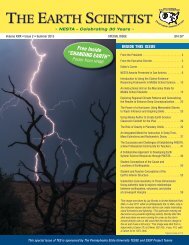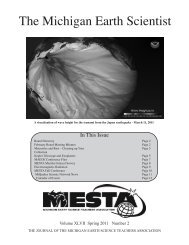The Earth Scientist
The earTh ScienTiST - NESTA
The earTh ScienTiST - NESTA
You also want an ePaper? Increase the reach of your titles
YUMPU automatically turns print PDFs into web optimized ePapers that Google loves.
Page 4<br />
<strong>The</strong> <strong>Earth</strong> <strong>Scientist</strong><br />
NESTA<br />
Coordinators<br />
Affiliates Coordinator<br />
Ron Fabich<br />
Conference Logistics<br />
Coordinators<br />
Kim Warschaw<br />
Michelle Harris<br />
Membership Coordinator<br />
Bruce Hall<br />
Merchandise Coordinator<br />
Howard Dimmick<br />
Procedures Manual<br />
Coordinator<br />
Parker Pennington IV<br />
Rock Raffle Coordinators<br />
Parker Pennington<br />
Kimberly Warschaw<br />
Share-a-thon Coordinator<br />
Michelle Harris<br />
Volunteer Coordinator<br />
Joe Manaco<br />
E-News Editors<br />
Missy Holzer<br />
Richard Jones<br />
Editor’s Corner<br />
<strong>The</strong> Incorporated Research Institutions for Seismology (IRIS) Consortium is pleased to partner<br />
with the National <strong>Earth</strong> Science Teachers Association (NESTA) to develop this special seismology<br />
focused issue of <strong>The</strong> <strong>Earth</strong> <strong>Scientist</strong>. <strong>The</strong> theme for this issue is Modernizing Your Seismology<br />
Education. Here you will find a collection of five invited articles that showcase the complexity and<br />
wealth of new teaching opportunities that exist within seismology education.<br />
While the place of seismology education in the earth science classroom is well established as an<br />
avenue to address many Nation Science Education Standards, instruction is too frequently limited<br />
to a dated view of seismology. Common activities include a variation on the classic 1960’s-era<br />
earthquake location exercise, plotting of global seismicity on a map to define <strong>Earth</strong>’s tectonic plates,<br />
and/or the use of a nomogram to determine the Richter magnitude for a local earthquake. While<br />
these exercises are not ineffectual, they do suffer from a number of issues that makes them less<br />
than desirable. For example, seismologists have rarely used the S-P method of earthquake location<br />
since the late 1960’s, and Richter magnitudes have largely been replaced by moment magnitudes. If<br />
seismic data are included as part of these activities for student analysis, they often look hand-drawn<br />
or inauthentic, which inappropriately glosses-over the inherent complexities of the <strong>Earth</strong>’s interior.<br />
Further, these activities focus on narrow aspects of seismic data (e.g. magnitude and event location)<br />
instead of helping students conceptualize seismic phenomena within a larger plate tectonic framework<br />
or addressing some of the major misconceptions students have about <strong>Earth</strong>.<br />
To fill the gaps left by commercially available instructional resources the IRIS E&O program is<br />
committed to developing and disseminating teaching materials and teacher-ready products. Such<br />
products are designed to impact a spectrum of learners from students in grades 5 to 16, to educators<br />
and the general public. <strong>The</strong>se translate into powerful learning experiences that transpire in<br />
a variety of educational settings ranging from the excitement and awe of an interactive museum<br />
exhibit hall 1 , to a major public lecture 2 , or the dynamic classroom of a teacher that has participated<br />
in one of IRIS’s professional development workshops 3 . Several such products are featured within<br />
this Modernizing Your Seismology Education issue of <strong>The</strong> <strong>Earth</strong> <strong>Scientist</strong>. Common across all five<br />
articles and the poster insert is the connection to new research that has yet to make it into commercially<br />
available textbooks or curricula.<br />
This issue features a two article sequence that introduces the geological phenomena of Episodic<br />
Tremor and Slip, one of the greatest seismological discoveries in the past decade, and describes<br />
how this phenomenon can be conveyed to students using models and kinesthetic learning. Another<br />
article explores how the USArray, a currently deployed dense network of seismometers, and<br />
resulting data can be leveraged to generate new visualizations to enhance the conceptualization<br />
of seismic waves in the classroom. <strong>The</strong> fourth article explores the ever-growing literature base of<br />
students’ alternative conceptions of geoscience topics and suggests strategies to use this to inform<br />
your curriculum, instruction and assessment. <strong>The</strong> final article introduces both new science on<br />
intraplate seismic zones and a physical model that can be used to explore this information with<br />
students. This piece is timely as we reach the bicentennial of the 1811-1812 New Madrid earthquakes.<br />
If you are reading this you have probably already opened and examined the poster we have included<br />
for you! Like the previously mentioned article on seismic waves, this poster also uses USArray<br />
1 http://www.iris.edu/hq/programs/education_and_outreach/museum_displays<br />
2 http://www.iris.edu/hq/programs/education_and_outreach/distinguished_lectureship<br />
3 http://www.iris.edu/hq/programs/education_and_outreach/professional_development<br />
© 2011 National <strong>Earth</strong> Science Teachers Association. All Rights Reserved.






